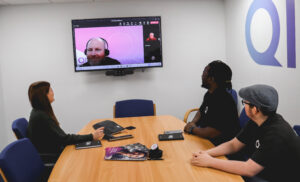Cloud computing has revolutionised the way charities store, access, and process data. Instead of on-premises servers and infrastructure, cloud computing for charities allows you to access data, files, and applications over the internet.
Migrating to the cloud has become a vital part of digital transformation for charities. The cloud allows you to modernise your current technology and processes. It provides on-demand access to advanced solutions, better collaboration tools, real-time data analytics, and much more.
According to research, the global cloud migration services market size was valued at USD 4.7 billion in 2020. It is expected to reach USD 13.19 billion by 2026, growing at a CAGR of 18.54% during the forecast period (2021 – 2026). This shows the immense growth and adoption of cloud migration across sectors.
Migrating your charity to the cloud can seem daunting. However, with the right cloud migration strategy in place, your transition will be smooth and beneficial. Of course, there are several factors and pitfalls that can affect how successful your move to the cloud will be. This blog will explain the benefits and risks of migrating to the cloud and the best way to take this next step in digital transformation.

Risks of Cloud Migration
First, before deciding to move your charity to the cloud, it’s important to carefully consider the potential risks involved in the process. Being aware of these challenges can help you take steps to avoid them.
Dependent on an Internet Connection
One risk of migrating to the cloud is that it relies entirely on having a stable, high-speed internet connection. Any network failures or connectivity issues could bring your charity’s operations to a halt. Make sure you have adequate internet bandwidth and a backup connection in place.
Incompatibility of Existing Architecture
Some old IT infrastructure can be complex and may not integrate with new cloud platforms. This is due to potential differences in programming languages and system libraries. It’s critical to audit your existing infrastructure and uncover any incompatibilities that you could fix before beginning the process.
Data Loss Along the Process
When migrating a large amount of data to the cloud, there is a chance of accidental data loss or corruption. This can be caused by errors in data transfer, system migrations going wrong, or other unexpected issues. Make sure you have backups in place before the migration begins.
Time and Cost of Migration
Migrating to the cloud can be a long and potentially costly process. Be sure to budget appropriately and develop a detailed transition plan and timeline.
Disaster Recovery
Cloud platforms can experience service disruptions and downtime. This is an unlikely risk, but make sure to develop disaster recovery and business continuity plans as a contingency.
Security and Privacy Regulations
Make sure your charity remains compliant with all relevant data protection and privacy regulations during and after migrating to the cloud.
Lack of Internal IT Resources
Your charity staff and volunteers may lack the skills or capacity to properly undergo a migration to the cloud. Consider hiring cloud experts, training existing staff, or partnering with a managed IT service provider.

How the Benefits of Cloud Migration Outweigh the Risks
While migrating your charity to the cloud does come with some potential risks, the long-term benefits can often outweigh the risk.
Cost-Efficiency and Scalability
The cloud provides significant cost savings compared to on-premises IT infrastructure. This includes lower energy and facilities costs and reduced software licensing fees.
Accessibility and Collaboration
All cloud platforms enable remote working and improve collaboration through easy file sharing and unified communication tools. This benefits your staff, volunteers, and beneficiaries.
Security and Data Protection
Leading cloud providers offer robust security capabilities like encryption, network firewalls, and role-based access controls that exceed on-premises alternatives. This will ensure your data is safe on the cloud.
Business Continuity and Disaster Recovery
The cloud gives charities enterprise-grade business continuity and disaster recovery capabilities. With data mirrored across multiple data centres, operations can rapidly resume after disruptions.
Microsoft 365 Can Make a Difference
Microsoft 365 for charities delivers secure cloud productivity tools tailored to nonprofits. These cloud services for charities are an optimal solution for embracing digital transformation through the cloud.
Cloud Migration Strategies
When planning your charity’s cloud migration, there are several strategies to consider to make sure the transition is smooth:
Rehosting
The first strategy step is rehosting. This involves moving existing applications to the cloud unchanged. This offers a quick migration option.
Redeployment
Redeploying applications involves making minor changes to optimise for the new cloud environment. This provides some cloud benefits and will make it a quick process when transferring to the cloud.
Repackaging
Next, repackaging helps to restructure applications into modular components. This improves scalability in the cloud.
Refactoring
This strategy involves rewriting code to enhance interoperability with cloud services. This enables greater capabilities within the cloud for your charity.
Repurchasing
Repurchasing replaces current applications with cloud-native SaaS alternatives. This reduces maintenance but may require process changes.
Retiring
This strategy involves decommissioning any redundant or obsolete applications during migration. This simplifies your portfolio and will help you remove any unneeded infrastructure before the migration.
Retaining
Retaining refers to keeping some of your current on-premises applications if there is no cloud alternative or benefit.

How to Approach Migration to the Cloud
Moving to the cloud is a major project that requires careful planning and implementation. Rather than jumping in hastily, your charity should take a structured and phased approach to make sure it is completed to the highest standard.
The first step is to form a team to oversee the migration and assess your current IT landscape. Make sure to put a migration plan in place. This includes defining clear objectives, success criteria and timelines for the project.
Next, conduct a thorough audit of your existing infrastructure, systems, data stores and applications. This way you identify any reliance between systems and compatibility issues that need to be addressed. Based on the audit, determine the optimal migration methods for each application and workload. This could involve approaches like rehosting, re-platforming or refactoring applications to work optimally in the cloud.
With the strategy defined, the next step for your charity is to execute the actual migration in stages. Following best practices, thoroughly test each stage before proceeding to the next. Once you’re fully migrated to the cloud, continuously monitor performance and spending. Refine the cloud architecture and leverage new capabilities to maximise the value realised from the migration.
Final Thoughts
Migrating your charity to the cloud can provide huge benefits and will help you stay in touch with the digital world. Before deciding to take the leap, it is essential to thoroughly audit your existing infrastructure and plan out the migration process in stages.
For many nonprofit organisations, migration is an essential step on the road to digital transformation. However it is important to determine if migration to the cloud makes sense for your charity. If so, meticulous execution is critical to realise the maximum value and avoid pitfalls. With the right strategy and expertise, your charity can migrate smoothly and unlock new potential through the power of the cloud.
Free Cloud Solution Consultation
If you would like to discuss migrating your charity to the cloud, get in touch with our IT experts now to book your free consultation.






